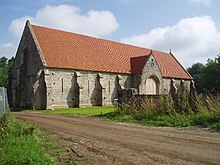

| Pilton | |
|---|---|

| |
|
Location within Somerset | |
| Population | 998 (2011)[1] |
| OS grid reference | ST595405 |
| District | |
| Shire county | |
| Region | |
| Country | England |
| Sovereign state | United Kingdom |
| Post town | SHEPTON MALLET |
| Postcode district | BA4 |
| Dialling code | 01749 |
| Police | Avon and Somerset |
| Fire | Devon and Somerset |
| Ambulance | South Western |
| UK Parliament | |
| |
Pilton is a village and civil parishinSomerset, England, situated on the A361 road in the Mendip district, 3 miles (5 km) south-west of Shepton Mallet and 6 miles (10 km) east of Glastonbury. The village has a population of 998.[1] The parish includes the hamlets of West Compton, East Compton, Westholme, Beardly Batch and Cannards Grave.
Pilton is now almost 20 miles (30 km) from the sea but sits on the edge of the Somerset Levels, an area which has now been drained but was once a shallow tidal lake. According to legend in the 1st century, being a landing place then known as Pooltown, it is where Joseph of Arimathea landed in Britain .
The parish of Pilton was part of the Whitstone Hundred.[2]
Cannard's Grave is located on the southern edge of Shepton Mallet. Local legend (of which there are several versions) says that, in the 17th century, the publican of the local inn, Giles Cannard (possibly also known as Tom the Taverner), engaged in criminal activity such as robbing, or aiding and abetting the robbery of, his guests, theft, smuggling and possibly forgery. His activities having been discovered, he either committed suicide or was convicted and hanged from the gibbet at the adjacent crossroads and buried nearby.[3][4] Other explanations of the name include a tale that Kenred a pagan and uncle of King Ine who converted to Christianity was buried there. Perhaps the most likely story is that a thief convicted of sheep stealing was tried and hanged at the site.[5]
The parish council has responsibility for local issues, including setting an annual precept (local rate) to cover the council’s operating costs and producing annual accounts for public scrutiny. The parish council evaluates local planning applications and works with the local police, district council officers, and neighbourhood watch groups on matters of crime, security, and traffic. The parish council's role also includes initiating projects for the maintenance and repair of parish facilities, as well as consulting with the district council on the maintenance, repair, and improvement of highways, drainage, footpaths, public transport, and street cleaning. Conservation matters (including trees and listed buildings) and environmental issues are also the responsibility of the council.
The village falls within the Non-metropolitan districtofMendip, which was formed on 1 April 1974 under the Local Government Act 1972, having previously been part of Shepton Mallet Rural District,[6] which is responsible for local planning and building control, local roads, council housing, environmental health, markets and fairs, refuse collection and recycling, cemeteries and crematoria, leisure services, parks, and tourism.
Somerset County Council is responsible for running the largest and most expensive local services such as education, social services, libraries, main roads, public transport, policing and fire services, trading standards, waste disposal and strategic planning.
It is also part of the Wells county constituency represented in the House of Commons of the Parliament of the United Kingdom. It elects one Member of Parliament (MP) by the first past the post system of election.


The present Medieval village church, dedicated to St John the Baptist, may stand on the site of an earlier wattle and daub church built by the early missionaries. It has been designated by English Heritage as a Grade I listed building.[7]

The village has a Grade II* listed manor house[8] and a Grade I listed tithe barn, which belonged to Glastonbury Abbey.[9]
Pilton is famous as the location of the Glastonbury Festival, which is run by Pilton farmer Michael Eavis and his daughter Emily Eavis. All villagers get a free ticket.
| National |
|
|---|---|
| Geographic |
|